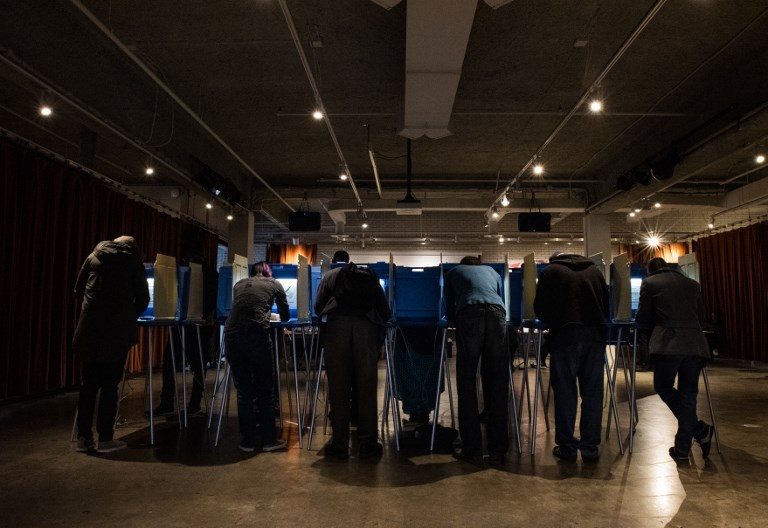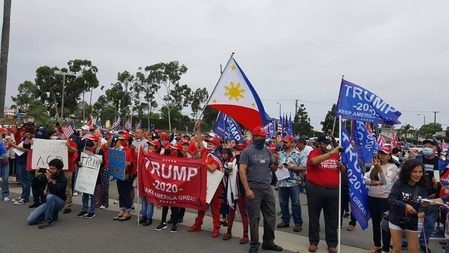SUMMARY
This is AI generated summarization, which may have errors. For context, always refer to the full article.

Undeterred by a pandemic, American voters headed to the polls on Tuesday, November 3, to deliver a verdict on who will lead the United States over the next 4 years as it faces a host of unprecedented challenges.
On the eve of Election Day, the US Elections Project reported early voters had already cast 71% of the total votes counted in the 2016 election, putting the 2020 race on track to have the highest voter turnout in years.
The historic numbers reflect the high stakes in the election between White House incumbent Donald Trump and Democratic candidate Joe Biden.
Behind the record-breaking numbers, who are the faces of American voters? One of the many groups to keep a close eye on would be minority voters, with subgroups like Hispanics and Asian Americans seeing greater participation in recent elections.
In the run-up to the 2020 election, the 2018 midterm polls saw all major racial and ethnic groups record a double-digit increase in voter participation.
Diving deeper, data from the Pew Research Center showed Asian Americans were the fastest-growing segment of eligible voters among major ethnic groups, with the number of eligible voters increasing by 139% from 2000 to 2020.
Findings from the Asian American 2020 voter survey also showed the growing importance of the group’s vote in key states like Nevada, North Carolina, Georgia, Texas, Florida, Pennsylvania, and Michigan.
Here’s what you need to know about Asian American voters:
How Asian American voters can shape elections
To understand the impact minority voters could have on the US election, consider this: US news outlet Axios said if people of color voted at the rate of White voters, “it would immediately alter who gets elected and what policies they pursue.”
While the group currently accounts for 4% of US voters, the Asian and Pacific Islander (AAPI) American Vote organization said the the Asian American and Pacific Islander electorate is projected to double from 5.9 million eligible voters in 2015 to 12.2 million eligible voters in 2040.
There are currently over 11 million eligible voters this year.
“The growth of AAPI influence and power extends beyond the political sphere, into all aspects of American society…. AAPIs are integral to the success of the American economy,” AAPI vote said, adding census data showed the group contributing nearly $1.1 trillion to the US economy every year.
On party identification
In 2020, more Asian American voters have identified as Democratic, with 44% identifying as such compared to 38% in the 2018 elections.
The Asian American 2020 voter survey by AAPI Vote and Asian Americans Advancing Justice (AAJC) found Asian Indians strongest on Democratic identification (54%), followed by Japanese and Koreans (51% respectively), Filipinos (46%), Chinese (38%), then Vietnamese (27%).
On the other end, Vietnamese Americans have historically been most aligned with Republicans (38%), followed by Filipinos (28%), Koreans (27%), Japanese (23%), and Asian Indians and Chinese (16% respectively).
Despite this, a considerable amount of Asian Americans (28%) also identified themselves as independent or “others,” with this greatest among Chinese (41%).
Trump or Biden?
At least as of September 2020, 54% of Asian Americans said they would be inclined to vote for Biden while 30% said they would vote for Trump. Another 15% remained undecided.
Yet only about 19% of Asian Americans said they had a “very favorable” view of Biden. This was the same for Trump, where 19% also shared having a “very favorable” view.
However, the share of Asian Americans voters who had a “somewhat favorable” view of Biden was larger with 34% of respondents indicating this, compared to only 16% for Trump.
Favorable views for Biden were strongest among Indians, whole favorability for Trump was highest among Vietnamese.
What issues do they care about?
Economy, health care, education, and racial discrimination were among the top concerns of the group for the 2020 election.
The findings were similar back to those in 2018, when jobs and the economy, health care, and education were among the top 3 election issues during midterm polls. At the time, this was followed by gun control, national security, and racial discrimination.
Where are they located?
Pew found more than half of Asian American voters live in only 3 states. Their say is concentrated in California, where 35% or 3.6 million of the Asian American electorate reside.
This was followed by New York (920,000 voters) and Texas (698,000 voters).
Meanwhile, Asian Americans were also the only major racial or ethnic group where naturalized citizens, rather than those born in the US, made up a majority of eligible voters, Pew said. – Rappler.com
Add a comment
How does this make you feel?


There are no comments yet. Add your comment to start the conversation.